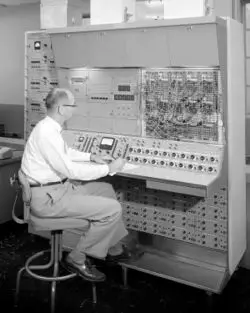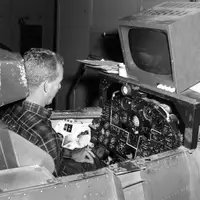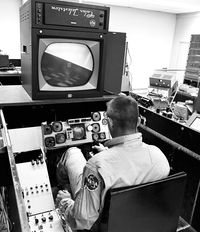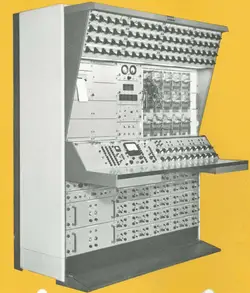m |
|||
| (4 intermediate revisions by one other user not shown) | |||
| Line 2: | Line 2: | ||
{{analog computer | {{analog computer | ||
|title = PACE 231R | |title = PACE 231R | ||
| − | |image = | + | |image = EAI PACE 231R (NASA, 1960).jpg |
| − | |caption = | + | |caption = PACE 231R, NASA/Glenn Research Center, 6/6/1960 |
|developer = [[Electronic Associates]] | |developer = [[Electronic Associates]] | ||
|manufacturer = [[Electronic Associates]] | |manufacturer = [[Electronic Associates]] | ||
| Line 13: | Line 13: | ||
|op range = +/- 10[[volt|V]] | |op range = +/- 10[[volt|V]] | ||
|components = {{list-1 | |components = {{list-1 | ||
| − | | 100 Op-Amp | + | | 100-324 Op-Amp |
| − | | 150 Pots | + | | 150-320 Pots |
| − | | 20- | + | | 20-42 Multipliers |
| − | | 20 Function Generators | + | | 20-34 Function Generators |
| Multimeters | | Multimeters | ||
| Power Racks | | Power Racks | ||
| Line 33: | Line 33: | ||
[[File:X-15 Simulator.png|thumb|right|200px|X-15 Simulator]] | [[File:X-15 Simulator.png|thumb|right|200px|X-15 Simulator]] | ||
In 1956, during the development of the North American X-15, no digital computer had the performance capabilities of delivering flight simulation calculations in real time which is why NASA chose the EAI PACE 231R analog computer instead. Three EAI 231R computers, containing 380 operational amplifiers, 101 function generators, 32 servo amplifiers, and 5 electrical multipliers networked together made up the simulator. The simulator covered 0.2 to 7.0 Mach at altitudes from sea level to 1,056,000 feet. It was not, however, capable of providing meaningful landing simulations. <ref name="x-15">{{cite book|last=Jenkins|first=Dennis|middle=R|title=X-15: Extending the Frontiers of Flight|year=2012|publisher=NASA (EBook)|pages=Chapter 6|ryear=2015|rmonth=12|rday=20|url=http://www.nasa.gov/connect/ebooks/aero_x15_detail.html}}</ref> | In 1956, during the development of the North American X-15, no digital computer had the performance capabilities of delivering flight simulation calculations in real time which is why NASA chose the EAI PACE 231R analog computer instead. Three EAI 231R computers, containing 380 operational amplifiers, 101 function generators, 32 servo amplifiers, and 5 electrical multipliers networked together made up the simulator. The simulator covered 0.2 to 7.0 Mach at altitudes from sea level to 1,056,000 feet. It was not, however, capable of providing meaningful landing simulations. <ref name="x-15">{{cite book|last=Jenkins|first=Dennis|middle=R|title=X-15: Extending the Frontiers of Flight|year=2012|publisher=NASA (EBook)|pages=Chapter 6|ryear=2015|rmonth=12|rday=20|url=http://www.nasa.gov/connect/ebooks/aero_x15_detail.html}}</ref> | ||
| + | === HL-10=== | ||
| + | [[File:HL-10 flight simulator, NASA, 1968.jpg|left|thumb|200px|HL-10 Flight Simulator.]] | ||
| + | Flight Research Center's first HL-10 simulations was done with the PACE 231R. As they described "The real capability of the analog computer was its ability to integrate differential equations. Because the equations of motion for the lifting bodies were differential equations-as are all equations of motion for aerospace vehicles-the simulation engineers mechanized them on available analog computers."<ref name="nasa1">{{apa web|last=Reed|first=Dale|middle=R.|month=August|year=1997|title=BACK TO THE DRAWING BOARD|web title =SP-4220 Wingless Flight: The Lifting Body Story|rmonth=12|rday=22|ryear=2015|url=http://history.nasa.gov/SP-4220/ch6.htm}}</ref> | ||
| + | {{clear}} | ||
===Langley Research Center / Project Mercury=== | ===Langley Research Center / Project Mercury=== | ||
In June 1960 EAI won a $1.51M contract to supply NASA's Langley Research Center with five fully expended PACE 231R systems. Those systems were used for various aspects of the Mercury project, including space station rendezvous. It was also used for the simulation of missile launches and satellites.<ref name="b1" /> | In June 1960 EAI won a $1.51M contract to supply NASA's Langley Research Center with five fully expended PACE 231R systems. Those systems were used for various aspects of the Mercury project, including space station rendezvous. It was also used for the simulation of missile launches and satellites.<ref name="b1" /> | ||
| Line 45: | Line 49: | ||
** Steam-generating heavy water reactor (SGHWR)<ref name="uk" /> | ** Steam-generating heavy water reactor (SGHWR)<ref name="uk" /> | ||
== Documents == | == Documents == | ||
| + | [[File:Eai 231R from brochure.png|250px|right|thumb|Photo From the 1958 Brochure.]] | ||
* [[:File:EAI 231R Manual (1960).pdf|EAI 231R Manual (1960)]] | * [[:File:EAI 231R Manual (1960).pdf|EAI 231R Manual (1960)]] | ||
* [[:File:EAI PACE 231R Brochure (1958).pdf|EAI 231R sales brochure (1958)]] | * [[:File:EAI PACE 231R Brochure (1958).pdf|EAI 231R sales brochure (1958)]] | ||
| Line 51: | Line 56: | ||
== References== | == References== | ||
{{reflist}} | {{reflist}} | ||
| + | |||
| + | {{meta counter|type=ac}} | ||
Latest revision as of 03:48, 23 December 2015
| PACE 231R | |

| |
| PACE 231R, NASA/Glenn Research Center, 6/6/1960 | |
| Developer | Electronic Associates |
| Manufacturer | Electronic Associates |
| Product family | PACE Series |
| Type | analog computer |
| Release date | 1958[1] |
| Introductory price | $20,000-1,000,000[1]
|
| | |
| Operating Range | +/- 10V |
| Components |
|
The PACE 231R was an analog computer developed by Electronic Associates in 1958[1]. The 231R was EAI's flagship computer becoming the most widely used analog computer system in the world - operating in various places well into the late 1970s and even early 1980s.
The EAI 231R is notable for having been used for simulation in many of the early space and aviation projects including the Project Mercury, Project Gemini, and the X-15.
Contents
Details[edit]
| This section is empty; you can help add the missing info by editing this page. |
Notable installations/applications[edit]
X-15[edit]
In 1956, during the development of the North American X-15, no digital computer had the performance capabilities of delivering flight simulation calculations in real time which is why NASA chose the EAI PACE 231R analog computer instead. Three EAI 231R computers, containing 380 operational amplifiers, 101 function generators, 32 servo amplifiers, and 5 electrical multipliers networked together made up the simulator. The simulator covered 0.2 to 7.0 Mach at altitudes from sea level to 1,056,000 feet. It was not, however, capable of providing meaningful landing simulations. [2]
HL-10[edit]
Flight Research Center's first HL-10 simulations was done with the PACE 231R. As they described "The real capability of the analog computer was its ability to integrate differential equations. Because the equations of motion for the lifting bodies were differential equations-as are all equations of motion for aerospace vehicles-the simulation engineers mechanized them on available analog computers."[3]
Langley Research Center / Project Mercury[edit]
In June 1960 EAI won a $1.51M contract to supply NASA's Langley Research Center with five fully expended PACE 231R systems. Those systems were used for various aspects of the Mercury project, including space station rendezvous. It was also used for the simulation of missile launches and satellites.[1]
Others[edit]
- NASA
- Goodard Space Flight Center, Washington DC
- Space Task Unit, Langley Research Center
- Ames Research Center, Moffet Field
- Manned Space Flight Center, Houston Texas
- United Kingdom Atomic Energy Authority
Documents[edit]
References[edit]
- ↑ 1.0 1.1 1.2 1.3 Small, James (2013). The Analogue Alternative: The Electronic Analogue Computer in Britain and the USA, 1930-1975. Routledge, 46. ISBN 9781134699025.
- ↑ Jenkins, Dennis (2012). X-15: Extending the Frontiers of Flight. NASA (EBook), Chapter 6.
- ↑ Reed, Dale. R.. (1997, August) "BACK TO THE DRAWING BOARD". SP-4220 Wingless Flight: The Lifting Body Story. Retrieved 12 22, 2015, from http://history.nasa.gov/SP-4220/ch6.htm.
- ↑ 4.0 4.1 Fry, Peter (2015). Remembering AEE Winfrith: A Technological Moment in Time. Amberley Publishing, 118-119. ISBN 9781445654799.


